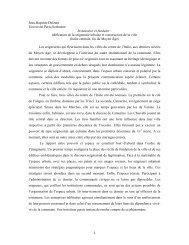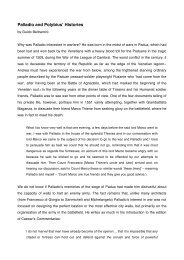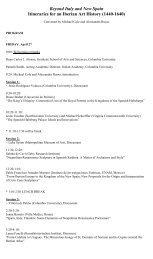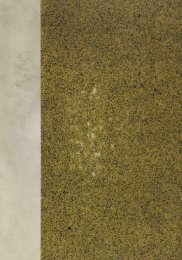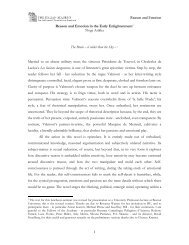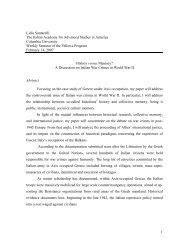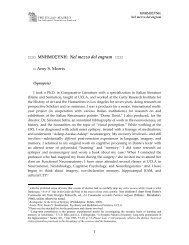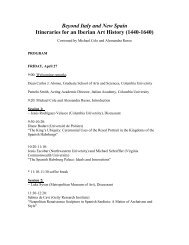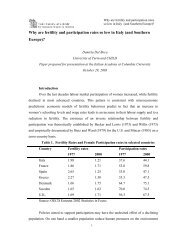Signa et res - The Italian Academy - Columbia University
Signa et res - The Italian Academy - Columbia University
Signa et res - The Italian Academy - Columbia University
Create successful ePaper yourself
Turn your PDF publications into a flip-book with our unique Google optimized e-Paper software.
<strong>Italian</strong> <strong>Academy</strong> for Advanced Studies in America<br />
at <strong>Columbia</strong> <strong>University</strong>, New York<br />
Luncheon Seminar, January 26, 2005<br />
Klaus Krüger<br />
<strong>Signa</strong> <strong>et</strong> <strong>res</strong> - <strong>The</strong> pictorial discourse of the imaginary in Early Modern Italy<br />
1. Preconditions: the Intentionality of Pictorial Rep<strong>res</strong>entation in the Christian Understanding<br />
of the Middle Ages<br />
<strong>The</strong> hermeneutics of the Christian Middle Ages assign the religious image and its aesth<strong>et</strong>ic<br />
function a status rich in an ambiguity and tension. <strong>The</strong> ambiguity is rooted in the question of<br />
the identity of the image, what Gadamer calls its “mode of being”. <strong>The</strong> tension occurs on<br />
account of the divergence b<strong>et</strong>ween the various aspects of the image: its independent actuality<br />
and its existence as a reproduction, its concr<strong>et</strong>e irreplaceability and its suspension of its own<br />
status.<br />
On the one hand, the image owes its special effectiveness to the relation attributed to it<br />
of verisimilitude (similitudo), which pred<strong>et</strong>ermines its power to make p<strong>res</strong>ent in visible,<br />
materialized rep<strong>res</strong>entations the experience of the invisible, immaterial reality of heavenly<br />
persons. In the <strong>res</strong>ulting paradoxical experience of the real p<strong>res</strong>ence of the numinous, which<br />
can even lead to the indistinguishability of copy and arch<strong>et</strong>ype, the immeasurable gap<br />
separating the earthly and the divine, the worldly and the transcendent appears to close. <strong>The</strong><br />
medium of the image lends concr<strong>et</strong>e form to the desired experience of the proximity and<br />
p<strong>res</strong>ence of the divine.<br />
On the other hand, at the same time the image also indicates the utter inaccessibility<br />
and insurmountable distance of the divine, in so far as it remains in its fundamental purpose a<br />
means of intentional reference to som<strong>et</strong>hing which it per se is not. It is the mediating role of<br />
all relations of similarity, which is inalienably inherent in the image. <strong>The</strong> image thus functions<br />
in its true sense as a medium, which must be transcended as part of an anagogically defined<br />
process leading to a recognition of the divine through a surpassing, pen<strong>et</strong>rating vision of what<br />
cannot be captured in images. “[...] to see God without any means, that’s contemplation”
(“[...] got sehen ane miteli, daz heiz contemplieren”) -- this is how in the late thirteenth<br />
century the “Büchlein von der Tochter Syon” (“<strong>The</strong> little Book of the daughter Syon”)<br />
describes the ideal of imageless vision in the sense of a mystical perception of grace. One<br />
encounters a similar concept of “de-imaging” (“entbildung”) and “imagelessness”<br />
(“bildlosigkeit”) in Henry Suso, Meister Eckhart, Johannes Tauler and other mystics of the<br />
fourteenth century.<br />
It is well-known that this conception of the image is based in large measure on a<br />
pictorial theory for which the foundations had already been laid in Antiquity by Platonic<br />
m<strong>et</strong>aphysics and that subsequently was adapted in medieval Platonism and applied to<br />
Christian ends. Here is rooted the basic ontologically invalidating ten<strong>et</strong> that, as the mere<br />
appearance of true, <strong>et</strong>ernal being, the image fails to contain in itself an exemplary existence<br />
and therefore possesses only an inessential existence. <strong>The</strong> m<strong>et</strong>aphorics according to which the<br />
work of a painter merely functions as a “shadow-image” of an always preexisting nature,<br />
which in turn only possesses anamn<strong>et</strong>ic powers by virtue of its reflection of m<strong>et</strong>aphysical<br />
validities, also provides the foundation for this hypostatically defined world view. On the<br />
basis of premises such as these, the exeg<strong>et</strong>ical tradition of the Middle Ages since Augustine<br />
continuously reformulated pictorial meditation as a preliminary, lower level along the<br />
contemplative ascent that leads, “per visibilia ad invisibilia”, from the visible to the invisible.<br />
This Christian hermeneutics or theory of symbolism endow the corporeal, painted<br />
image with a paradox inherent in the merging of its dual d<strong>et</strong>ermination, which consists of<br />
being both realized in itself and referring beyond itself. Images provide the incentive and<br />
impulse for perception, which, while it requi<strong>res</strong> them, non<strong>et</strong>hless is directed at a truth that<br />
always lies beyond them. On this paradox is founded the value as well as the futility of the<br />
image: the desire for perception oriented beyond the image can envisage the truth only<br />
through the appearance of the image. Only in this way, which is founded in the subsequent<br />
insight into the intentionality of the rep<strong>res</strong>entation, can one realize even more emphatically<br />
the categorical alterity of what remains pictorially incomprehensible.<br />
To understand the intentionality of the rep<strong>res</strong>entation was a theor<strong>et</strong>ical objective that<br />
had an impact, not only on mystics and on arguments concerning theological aesth<strong>et</strong>ics, but<br />
also on concr<strong>et</strong>e practices involving the daily use of images. Practice, be it in the production<br />
or reception of images, joined theory in increasingly identifying the image as a specific<br />
medium. <strong>The</strong>se two areas -- the aesth<strong>et</strong>ic conceptualization of the image and its pragmatic<br />
applications -- do not rep<strong>res</strong>ent independent levels of discourse. <strong>The</strong>y interact as part of a<br />
2
complex dialogue and exchange that involves affirmation as well as contradiction and that<br />
provides the basis for various forms of continuity and discontinuity.<br />
<strong>The</strong> testimonies and reports provided by hagiographical writings and visionary<br />
literature -- the literary forms which provide the point at which the two levels of discourse on<br />
the image me<strong>et</strong> and converge -- lend eloquent exp<strong>res</strong>sion to this s<strong>et</strong> of ideas. Time and again,<br />
these writings describe visions that were experienced during the viewing of painted pictu<strong>res</strong><br />
and that were stimulated by the images’ powers of communication. For example, the vita of<br />
Pope Gregory VII from the late eleventh century relates how P<strong>et</strong>er once appeared to him in an<br />
vision in a manner that he recognized from pictorial rep<strong>res</strong>entations, “ut in picturis videre<br />
solebat.” A female admirer of Chiara da Montefalco experiences the saint, whom she had<br />
never encountered during her lif<strong>et</strong>ime, in an inner vision in the very way in which she<br />
appeared in the painted image above her tomb: “in forma cuiusdam picturae quae est super<br />
sepulchrum dictae Sanctae Clarae.” “Raising her eyes to the sky,” (“levando gli occhi in<br />
verso il cielo”) Catherine of Siena experienced repeated visions of P<strong>et</strong>er and Paul, John and<br />
Dominic “in the form in which they are seen painted in the church” (“in quella forma che<br />
veduta l’avea dipinto nella chiesa”) according to a hagiographic legend of ca. 1375. One<br />
could easily adduce additional reports of this kind. Som<strong>et</strong>hing similar, according to legends<br />
handed down from the late Medieval period, was experienced by Catherine of Alexandria,<br />
who was once given a painted panel by a hermit which depicted the Virgin with the infant<br />
Jesus. She surrendered to the image in such a state of inner, self-absorbed contemplation that<br />
on the same night, in the silent darkness of her chamber, she actually experienced an<br />
apparition of the Holy Virgin, an event which, as we know, culminated in her mystical<br />
marriage to Christ. In their repeated tropes, accounts such as these testify to the ambiguity<br />
attributed to the type of reality inherent in the rep<strong>res</strong>entation. <strong>The</strong> material image supplies the<br />
source for an internally imagined image, in which it is reproduced and replicated, but at the<br />
same time also dissolved. <strong>The</strong> image is thus capable of generating a form of perception that<br />
combines the perception of similarity with the experience of difference.<br />
Reports of visionary experience were always able to lend a special authenticity to<br />
materially manufactured images, which they initially only credited as reflections of a higher<br />
reality. In this way, the assumed relationship b<strong>et</strong>ween the original image and its rep<strong>res</strong>entation<br />
functioned at the same time as mutual accreditation. <strong>The</strong> notion of the image as mediator and<br />
membrane b<strong>et</strong>ween the visibilia and the invisibilia thus enabled instrumentalizations that<br />
diminished, often to the point of their disappearance, distinctions b<strong>et</strong>ween the rep<strong>res</strong>ented and<br />
the rep<strong>res</strong>entation, the prototype and its painted reproduction. Whenever the image was<br />
3
imbued with the reality of a personal p<strong>res</strong>ence, its reception allowed for the rep<strong>res</strong>sion of any<br />
consciousness of its supposed openness or transparency to a being belonging to a higher<br />
reality. Images of this kind, which contained their own powers of grace, and which acted<br />
independently by speaking and moving, by crying, sweating and bleeding, could themselves<br />
be endowed in this manner with the privilege of a revelatory essence. As materialized<br />
emanations of the divine, they themselves became objects of a revelatio. At festively staged<br />
moments of their own unveiling, they were revealed to the gaze of the faithful like a mystery<br />
unveiled.<br />
2. Transparency and Opacity: the new meaning of autoreflexive signs<br />
Examples such as ‘miraculous’, ‘speaking’, or even ‘moving’ images underscore that for the<br />
image to refer in a self-conscious fashion to its status as a medium required in a categorical<br />
sense a distancing attitude on the part of the viewer. This distancing first allowed for an<br />
aesth<strong>et</strong>ic differentiation b<strong>et</strong>ween the ‘how’ and the ‘what’ of the rep<strong>res</strong>entation, and vice<br />
versa. <strong>The</strong>refore it becomes clear that the marking of the image as a medium came up as a<br />
claim on its own aesth<strong>et</strong>ic conception, i.e. the marking itself formed part of the image’s task<br />
or function. This claim became increasingly urgent as in early modern times the image, in<br />
acquiring what Louis Marin and others call the dimension of “mim<strong>et</strong>ic transparency,”<br />
increasingly lost its material character as a medium of p<strong>res</strong>entation. <strong>The</strong> more the image<br />
defined itself as an imitation of visible reality, as an “open window” in Alberti’s sense<br />
(“finestra aperta”), the less it opened a view onto a m<strong>et</strong>a-pictorial reality. <strong>The</strong> tension<br />
<strong>res</strong>ulting from two such different demands on the image required a f<strong>res</strong>h approach to basic<br />
issues of rep<strong>res</strong>entation. In self-referential fashion, the aesth<strong>et</strong>ic practice elevated the problem<br />
of rep<strong>res</strong>entation in new and hitherto wideley unexperienced ways to a productive moment<br />
within the rep<strong>res</strong>entation itself.<br />
In Renaissance painting -- and in its related aesth<strong>et</strong>ic theories as well (Alberti, Piero<br />
della Francesca, Filar<strong>et</strong>e, Leonardo ecc.) -- the image becomes transparent, but whatever can<br />
be seen through it no longer participates in the m<strong>et</strong>aphysical dimension of the object based on<br />
the Platonic idea, but only in their optical mode of being. With this shift there occurs a<br />
remarkable change in what Blumenberg would call the “the sense of ontological foundation”<br />
of painting and, moreover, in the conceptual framework of the image’s epistemological<br />
function. This newly coined function claims that the painted rep<strong>res</strong>entation is defined first and<br />
4
foremost in terms of an aesth<strong>et</strong>ic logic premised on a subject-centered, pictorial vision.<br />
Rather than aspiring to the status of an ontological rep<strong>res</strong>entation, it displays ‘reality’ as<br />
conditioned by its human point of view. In this context, it is important to note that Alberti’s<br />
famous treatise on perspective (and in general on painting: Della pittura, 1435) does not<br />
constitute subjectivism avant la l<strong>et</strong>tre. Rather, it focuses on the intersubjective rationalization<br />
of pictorial vision, which Alberti and his contemporaries employ to establish the ‘reality of<br />
rep<strong>res</strong>entation’ as costruzione legittima and to justify painting against the suspicion of an<br />
arbitrarily deceptive, shadow-like image. In this way, painting becomes a form of knowledge,<br />
a matrix of human understanding, and an interpr<strong>et</strong>ation of reality based on scientific, rh<strong>et</strong>oric<br />
and <strong>et</strong>hical comp<strong>et</strong>ence (the doctrines of perspective, exp<strong>res</strong>sion and affects ecc.). At the<br />
same time, however, it removes itself from demands that the image be anchored within an<br />
objective, p<strong>res</strong>tabilized ‘truth’. Nobody seems to clarify this point b<strong>et</strong>ter that Alberti’s<br />
younger contemporary Filar<strong>et</strong>e (ca. 1460-64), who appears to side with the critics of<br />
perspectival design when he cites what he sees as their inherent danger of providing a<br />
thoroughly deceptive and superficial illusion, in so far as painting is capable of simulating<br />
som<strong>et</strong>hing which does not really exist. At the same time, Filar<strong>et</strong>e nevertheless st<strong>res</strong>ses that<br />
the design of the image itself, or rather its character as a sign (“disegnio”) possesses a<br />
meaningful truth of its own, which does not <strong>res</strong>ide in signifying a pre-existing object, but<br />
rather in the demonstration that the rep<strong>res</strong>ented object is defined by the conditions of vision<br />
and pictorial rep<strong>res</strong>entation.<br />
What we see here is a ‘new truth’ of the image, a truth that in the end manifests itself<br />
in its own aesth<strong>et</strong>ic logic of rep<strong>res</strong>entation, to be precise, in the principle of its visual mode of<br />
existence. In so far as this logic adhe<strong>res</strong> to the rational and implicitly ideal laws of measure<br />
and order, painting creates beauty. Not only that, it also conveys the concept and categorical<br />
knowledge of beauty at the same time. Alberti already understood this and argued accordingly<br />
by superimposing the leading law of proportionality (“compositio”) over the arrangement of<br />
signs i.e. of the dots, lines and planes, which are the elementary building components of the<br />
rep<strong>res</strong>entation of an object. In accord with the same principles Alberti elevated as the maxim<br />
of painting their systematic composition on the picture plane in keeping with their rational<br />
coherence: “Composition we call that procedure in painting (ragione di dipigniere), after<br />
which the single parts of seen things (cose vedute) are arranged and harmonized in the<br />
painted picture (in pictura). [...] Parts [...] are the bodies, parts of the bodies are the members,<br />
parts of the members the surfaces. At first painting is concerned with surfaces. <strong>The</strong><br />
composition of surfaces (compositione della superficie) has the effect that the bodies possess<br />
5
that grace, which is called beauty (bellezza).” Beauty, which had previously, in the Platonic-<br />
Pythagorean tradition, been understood in terms of the harmonious order of the cosmos, now<br />
is turned into an immanent category, in the sense of the image itself as a harmonious totality.<br />
In other words, the image itself becomes the actual locus of beauty.<br />
It should be pointed out that more and different issues are here at stake than the<br />
realization of an art apostrophized as ‘autonomous.’ In an elementary fashion, the arguments<br />
touch on the issue of aesth<strong>et</strong>ic reality and its significance, more precisely on the nature of<br />
pictorial mimesis. Alberti had already recognized this dimension of the problem in add<strong>res</strong>sing<br />
the momentous shift that occurs when in the aesth<strong>et</strong>ic perception of the image the divine<br />
quality inherent in the artist’s work comes to cloak the divinity of the person rep<strong>res</strong>ented per<br />
se. When this substitution occurs, the implied identity of the rep<strong>res</strong>ented subject is, as it were,<br />
absorbed into the aesth<strong>et</strong>ic reality of the rep<strong>res</strong>entation itself, and the effect of the former<br />
depends increasingly on the aura of the latter. This nexus is characterized by an inner paradox,<br />
in that for Alberti the “brilliance” of the rep<strong>res</strong>entation <strong>res</strong>ults first and foremost from the<br />
artist’s mim<strong>et</strong>ic performance and his ability to conjure up for the viewer the subject’s<br />
illusionistic p<strong>res</strong>ence. As Alberti puts it: “painting contains a truly divine force (forza divina).<br />
Not only does it, like friendship, cause people from far away to be p<strong>res</strong>ent before us, even<br />
more, it makes it seem that the dead come alive after many centuries, so that we view the<br />
work with great admiration for the artist (molta admiratione del artefice) and with great<br />
pleasure of our own (con molta volupta) time and again. [...] As a <strong>res</strong>ult, it is certain that the<br />
appearance of someone who deceased long ago lives a long life through painting.”<br />
Alberti attributes to artistic mimesis the almost salvific grace of bestowing life upon<br />
the person rep<strong>res</strong>ented after his death. He thereby p<strong>res</strong>umes a dual effect created by painting<br />
in the viewer: on the one hand, the effect of illusion, on the other hand, the effect of the<br />
aesth<strong>et</strong>ic experience of that illusion. What this implies for the rep<strong>res</strong>entation of religious<br />
subjects, he makes clear in the continuation of his comments: “And it is certainly the greatest<br />
gift for the mortals, that painting would make p<strong>res</strong>ent the gods, which were venerated by the<br />
peoples, by so supporting that pi<strong>et</strong>y, which joins us to the gods and keeps our souls full of<br />
religion. <strong>The</strong>y say that Phidias in Aulis created a god Juve, whose beauty (bellezza)<br />
considerably strengthended the religion than current”.<br />
It is remarkable that, in order to demonstrate the “divine force” (“forza divina”) of art,<br />
Alberti both draws on portraits of persons and cult images of the Gods. He refers to one genre<br />
to butt<strong>res</strong>s art’s claim to authenticity based on its mim<strong>et</strong>ic capacity, and to the other to<br />
demonstrate its persuasive force aimed at persuading the viewer. <strong>The</strong> religious image should,<br />
6
on the one hand, create a convincing, and in fact ‘believable’ imp<strong>res</strong>sion of the rep<strong>res</strong>ented<br />
subject; on the other hand, however, it should first and foremost affect the beholder on<br />
account of its beauty (“bellezza”). Not by accident, this discussion had recourse to Antique<br />
prototypes. <strong>The</strong> praise of art’s mim<strong>et</strong>ic powers, which makes it possible for images to<br />
rep<strong>res</strong>ent things that do not exist as if they actually did, is a topos in the art critics of<br />
Antiquity. Philostrat draws on it directly in commenting on the creation of statues of the<br />
Gods. A Phidias or a Praxiteles, he remarks, certainly had never ascended to heaven to<br />
fashion “portraits” of the Gods. Consequently, such creative achievements must be attributed<br />
to their artistic “phantasia”. Mimesis alone, Philostrat insists, merely recapitulates visible<br />
phenomena, while is also capable of rep<strong>res</strong>enting the invisible. In the same vein, Alberti<br />
connects the believability of the rep<strong>res</strong>entation, and hence its religious powers of persuasion,<br />
not so much to the qualities of similarity or authenticity, but instead far more to the purely<br />
aesth<strong>et</strong>ic criterion of beauty ("bellezza"), and, still more, to its essential quality of ambiguity<br />
and vagueness (“vaghezza”) and its impact upon the beholder. <strong>The</strong> conclusion following from<br />
this for the semiotic structu<strong>res</strong> of such images of gods or saints will be readily apparent: the<br />
psychological impact, the beholder’s expectations of and yearnings for heavenly grace<br />
associated with the contemplation of images have their points of departure in the visible - not<br />
the invisible - aspects of the rep<strong>res</strong>entation.<br />
3. Emancipation and Authority: the Control of the Gaze<br />
Alberti’s position, which is based on antecedents from Antiquity, reveals a conception of<br />
rep<strong>res</strong>entational credibility that depends fundamentally on the artist’s creative comp<strong>et</strong>ence<br />
and the allure of his work. Alberti’s arguments mark the beginnings of a long development<br />
that increasingly emphasized art’s “bellezza” and the individual artist’s creativity to be the<br />
critical criteria on which the religious efficaciousness of the image depended. In the act of<br />
painting (“dipingniendo”), the painter infuses the work with the effective force of his artistic<br />
aura as if by the secularized power of grace (“quasi uno iddio”). It is the same “bellezza<br />
nuova e più viva” that at a later date Vasari also has in mind when, in the course of his<br />
discussion of the development of art during the Quattrocento, he states that people gathered in<br />
astonishment around as if in the p<strong>res</strong>ence of a revelation of absolute, even divine splendor.<br />
<strong>The</strong> process of this “transfer of artistic objectivity into the realm of the phenomenal”,<br />
as Panofsky described it, and accordingly, the whole contemporary question about the<br />
7
image’s constitutive ambivalence b<strong>et</strong>ween materiality and transparency, b<strong>et</strong>ween original and<br />
reproductive existence, b<strong>et</strong>ween similarity and difference ecc. is intimately bound up with its<br />
effects on the beholder. More precisely, we encounter the question wh<strong>et</strong>her the potency of<br />
pictorial experience on the part of the observer leads either toward the fixation in the<br />
beholder’s mind of som<strong>et</strong>hing he regards as concr<strong>et</strong>e and objective, thereby reducing the<br />
scope available to the play of fantasy by delivering the imprint of a compl<strong>et</strong>e and coherent<br />
illusion, or wh<strong>et</strong>her the image instead activates and liberates the imagination, facilitating the<br />
production of individualized interior images.<br />
Needless to say, behind this question lies another of far-reaching complexity, namely<br />
that concerning the social and religious effectivity inhering in relations b<strong>et</strong>ween authority and<br />
emancipation, and not least of all questions concerning the criteria, exeg<strong>et</strong>ical comp<strong>et</strong>ence<br />
and norm-defining powers of pictorially generated authenticity. <strong>The</strong> ongoing process of the<br />
'desubstantialization' of the invisible, that is to say, of the accumulation of insights into its<br />
categorical dependency upon the medium of p<strong>res</strong>entation, opened up a multitude of ways in<br />
which images were exploited especially during the Counter-Reformation and in the context of<br />
its struggles for discursive hegemony and for the domination of the imaginary. Art theorists of<br />
the Catholic reform such as Giovanni Andrea Giglio, Giulio Castellani, Gabriele Paleotti,<br />
Johannes Molanus and many others opposed the proceeding dissociation of religious and<br />
aesth<strong>et</strong>ic experience, which they p<strong>res</strong>umed in Renaissance art, by a program that aimed at a<br />
reintegration of artistic aspirations and sacred function. <strong>The</strong>y actively took issue with the<br />
criticisms p<strong>res</strong>ented by Protestant reformers and joind them in deploring continued<br />
impropri<strong>et</strong>ies, mistakes and errors (“errori”) that artists committed in the rep<strong>res</strong>entation of<br />
religious subjects and, not least, the vain striving for ostentatious splendor, artistic effect, and<br />
beauty. By linking their criticism, however, with a call for a moral renewal of painting, they<br />
aimed at bringing about a different <strong>res</strong>ult, a rebirth of art out of the spirit of a new artistic<br />
<strong>et</strong>hic.<br />
In concr<strong>et</strong>e terms this call for Catholic reform meant that the p<strong>res</strong>ervation of images as<br />
a medium of religious communication required careful pastoral control of their use and<br />
theological oversight of their production. <strong>The</strong> Council of Trent (1545-1563) placed special<br />
emphasis on the stipulation that bishops and, in the last instance, the Pope, have the right to<br />
oversee images. Lodovico Dolce recommends systematic forms of censorship or punishments<br />
for painters who do not conform to the commands of artistic <strong>et</strong>hics. Authors such as Raffaele<br />
Borghini, Paleotti and, before them, Giglio da Fabriano, demand that artists always seek<br />
thorough counseling from a theologian. Lomazzo takes this even further in recommending not<br />
8
only that painters frequently engage in intellectual exchange with theologians (“frequente<br />
conversazione con teologi”), but further that they consider as indispensable the independent<br />
acquisition of theological knowledge. <strong>The</strong>se demands ultimately coalesce with the call for an<br />
all-encompassing renewal of the style of Christian rep<strong>res</strong>entation and rh<strong>et</strong>oric, the creation of<br />
a new rh<strong>et</strong>orica divina.<br />
<strong>The</strong> attainment of so thoroughgoing a goal required not only the theological schooling<br />
of artists, but, still more important, their <strong>et</strong>hical integrity and a correct Christian attitude.<br />
Time and again Fra Angelico functions as the prototype of the ideal painter, who, as Paleotti<br />
phrases it, was so filled with faith “ut interiorem devotionem ac pi<strong>et</strong>atem foris <strong>et</strong>iam penicillo<br />
repraesentar<strong>et</strong> [...]”. <strong>The</strong> work of the artist can be understood as the product of internal<br />
adherence to a pious way of life. <strong>The</strong> Bolognese Cardinal Gabriele Paleotti praises in his<br />
treatise on images (1582) the example of “alcuni pittori, scultori <strong>et</strong> altra formatori de<br />
imagini, che sono stati nel numero de’ santi e beati, o riputati di buonissima <strong>et</strong> essemplare<br />
vita,” and holds up the Evangelist Luke, the painter of the Madonna and the patron saint of<br />
painters as an exemplary model. In the Bull of 1577 that marked the foundation of the<br />
Accademia di San Luca in Rome, Pope Gregory XIII exp<strong>res</strong>sed his expectation, that artists of<br />
deep religious convictions and pious conduct would be educated within its walls. In keeping<br />
with this program, common prayer formed part of the educational program as did lectu<strong>res</strong><br />
about matters of Christian faith and pious conduct. In framing the artist as a practioner whose<br />
way of working was prefigured by God’s act of creation and whose production testifies to the<br />
emanation of a higher, divine grace, the Catholic reform’s conception of artistic practice<br />
rep<strong>res</strong>ents basically a continuation of Byzantine and medieval conceptions.<br />
In accordance with these trends, after initial reluctance, the decade of the 1560’s<br />
witnessed renewed efforts to revive the cult and propagation of venerable miracle-working<br />
image and acheiropoi<strong>et</strong>a. <strong>The</strong> same strong inte<strong>res</strong>t asserting the continuity of sacred traditions<br />
related to images is seen, when, in 1564, less than a year after the stipulations of the Council<br />
of Trent, Giovanni Andrea Giglio requested of painters that they should “dipingere le sacre<br />
immagini oneste e devote, con que’ segni che gli sono stati dati dagli antichi per privileggio<br />
della sanità.” Paleotti, Molanus and many others concur with this demand. Caveats such as<br />
these all supplies evidence of a desire to <strong>res</strong>trict or even redirect artistic mimesis. Rather than<br />
focusing directly on the object of rep<strong>res</strong>entation (i.e., on Christ, the Virgin, or the saints), it<br />
should, according to these critics, reflect its reality indirectly and in a fashion mediated by the<br />
established rules and bequeathed paradigms of a sacred tradition.<br />
9
Considered in its entir<strong>et</strong>y, the Catholic call for a recontextualization of Christian art<br />
seeks to legitimize and provide new justification of its claims to an inherent sacrality. <strong>The</strong><br />
focus of the reform is the reintegration of the process of artistic production with the religious<br />
character of the product, an integration of aesth<strong>et</strong>ics and function that would overcome the<br />
dichotomy that, from the theologians’ point of view, had opened up b<strong>et</strong>ween art and religion<br />
in the wake of an erroneous historical development.<br />
4. Authentification vs. Fictionalization: the pictorial discourse of the imaginary<br />
A reintegration of artistic practice and production defined in these terms does not,<br />
however, alleviate or eliminate the problem of the offending dichotomy, it only displaces it.<br />
<strong>The</strong> problem now manifests itself in the radical reduction and <strong>res</strong>triction of art’s purpose and<br />
efficacy. As stipulated by rep<strong>res</strong>entatives of the Catholic reform, the new, theologically<br />
informed notion of art’s “virtue” (“virtù de l’arte”) and of the artist’s “ingegno” can be<br />
understood only as a r<strong>et</strong>rospective <strong>res</strong>ponse to the novel formulations of artistic independence<br />
and genuine po<strong>et</strong>ic license as they were developed in humanist art theory of the Quattrocento<br />
and then put into practice under the rubrics of, inter alia, disegno, invenzione, fantasia, and<br />
giudizio.<br />
<strong>The</strong> art theory of the Catholic reform was ultimately predicated on the p<strong>res</strong>umption of<br />
a dichotomy, a distinction b<strong>et</strong>ween two kinds of art. As Paleotti stated, a painter can be seen<br />
either as a pure artist (“puro artefice”) or as a Christian artist (“artefice cristiano”). He<br />
accordingly distinguishes b<strong>et</strong>ween the painting of sacred and profane images (“imagini sacre<br />
e profane”). <strong>The</strong> differences b<strong>et</strong>ween the two modes manifest themselves in the works as well<br />
as in the viewer and his manner in which he <strong>res</strong>ponds to them. This kind of argumentation<br />
s<strong>et</strong>s a pattern. For example, when Raffaele Borghini condemns the lascivious elegance of the<br />
naked figure of an angel in Bronzino’s famous “Resurrection of Christ” (1552) in SS.<br />
Annunziata in Florence as “som<strong>et</strong>hing unfitting” (“cosa disconvenevole”) in an ecclesiastical<br />
image, it does not prevent him from admitting at the same time that, were it in a private<br />
collection, the image would be of the highest artistic value.<br />
<strong>The</strong> stipulations of Catholic reformers do not add<strong>res</strong>s the question to what extent<br />
images can both function as instruments of religious revelation and at the same time integrate<br />
this form of functioning with their aesth<strong>et</strong>ic character as works of art. <strong>The</strong> two aspects are<br />
rather construed as divergent, even incompatible options. <strong>The</strong> dichotomy that opens up in the<br />
10
art theory of the Catholic Reform b<strong>et</strong>ween religious and aesth<strong>et</strong>ic experience as two<br />
h<strong>et</strong>eronomous, hierarchically distinct sphe<strong>res</strong> of signification is predicated on the authority of<br />
a narrowly defined notion of artistic imitation. <strong>The</strong> emergence of this dichotomy could be<br />
characterized as an effort to revise the precept of art’s independence from or superiority over<br />
nature as it was developed in Renaissance and Mannerist aesth<strong>et</strong>ic theory, in which it served<br />
to uphold the artificial and the artistic as realities in their own right as opposed to the natural.<br />
Paleotti requi<strong>res</strong> that the artist bind his rep<strong>res</strong>entation exclusively to the reality rep<strong>res</strong>ented by<br />
nature and history, i.e., to the tradition of Scripture and hagiography. He emphatically denies<br />
painters the right to rep<strong>res</strong>ent designs of their own imagination (“cose che s’hanno<br />
imaginate”) in the inte<strong>res</strong>t of visualizing the divine: “[...] diciamo che, essendo l’officio del<br />
pittore l’imitare le cose nel naturale suo essere e puramente come si sono mostrate agli occhi<br />
de’ mortali, non ha egli da trapassare i suoi confini, ma lasciare a’ teologi e sacri dottori il<br />
dilatare ad altri sentimenti più alti e più nascosti” By these standards, art can only reproduce<br />
what can be seen in nature: “Altrimente serìa un confondere ogni cosa e passare<br />
tumultariamente dallo stato della natura a quello della grazia o della gloria.” Paleotti<br />
excludes the infusion of divine grace (“grazia”) from the artist’s actual process of design. In<br />
its wording, Paleotti’s postulate recalls Alberti’s argument that “the things that we cannot see<br />
[...], do not concern the painter.” Its actual intent, however, is utterly different, in that it is not<br />
predicated on the notion of perspectival, pictorial vision, but instead on an ontologically<br />
binding correlation of appearances and nature’s essence.<br />
Paleotti argues in favor of a normative understanding of imitation that is framed and<br />
justified in spiritual terms. His position denies to aesth<strong>et</strong>ic fictions the potential to create<br />
religious meaning or the capability of prompting the confession of Christian truth. It also<br />
leaves no room for either artistic invention or an aesth<strong>et</strong>ic of the obscure or vague, the artistic<br />
or multi-dimensional (“pitture oscure e difficili da intendersi”). As literal, factual modes of<br />
existence, nature and history p<strong>res</strong>ent themselves as exp<strong>res</strong>sions of a universal and<br />
authoritative divine will. Any willful deviation from this will rep<strong>res</strong>ents a p<strong>res</strong>umptuous<br />
violation against transcendentally guaranteed truth and as such an aesth<strong>et</strong>ic offense. What we<br />
witness here is a revival of the kind of thinking that, in keeping with a tradition that can be<br />
traced back to Isidore of Seville and others, attempts to play off truth against fiction, history<br />
against po<strong>et</strong>ry, and which believes that Christianity’s claim to a higher spiritual ‘truth’ can<br />
only be secured by artistic forms of “anti-fiction.”<br />
Prompted in part by criticism from the Protestant quarter apologists of the Catholic<br />
Reform sought to free Christian art from the odium of illusion and falsehood. <strong>The</strong> theor<strong>et</strong>ical<br />
11
position of the Reform rep<strong>res</strong>ents a r<strong>et</strong>rograde attempt to save art by <strong>res</strong>tricting it to religion.<br />
In the end, however, the reformers failed to come to terms in a relevant, productive way with<br />
the issue of how to integrate aesth<strong>et</strong>ic and religious experience in appropriate ways. <strong>The</strong><br />
recourse to an understanding of imitation that insists on the close equivalence of reality and<br />
the works that seek to rep<strong>res</strong>ent it <strong>res</strong>ists a new, pluralistic and contextualized notion of ‘truth’<br />
no longer being capable of supplying a securing standard for the creation of meaning. Once<br />
the closed frame of reference linking <strong>res</strong> and signum, thing and sign, had lost its validity as a<br />
definitive way of defining the human cognition, there occured a momentous shift in the the<br />
relationship b<strong>et</strong>ween dicere (speaking) and significare (signifying), fiction and truth. “Truth<br />
in its strict sense of adaequatio henceforth remains possible only for whatever man has<br />
created by him self and what can therefore be p<strong>res</strong>ent entirely and without symbolic<br />
mediation [...]. <strong>The</strong> relation of truth ranking absolute can no longer be considered b<strong>et</strong>ween the<br />
rep<strong>res</strong>enting work of art and the rep<strong>res</strong>ented nature, but b<strong>et</strong>ween the understanding subject<br />
engaged within art and the artistic entity, which he regards as a piece of reality created at least<br />
according to his potential. Man no longer comp<strong>et</strong>es in relation with nature as a creation<br />
alienated from him, but in his own cultural works with the immediacy, which God can use in<br />
the treatment of his works as their creator and spectator. <strong>The</strong> m<strong>et</strong>aphysical dignity, which had<br />
never before been known, of the work of art is founded in this transformation and split of the<br />
term of truth, which signifies <strong>res</strong>triction and intensification at the same time.”<br />
<strong>The</strong> claim that art can generate a new and alternate nature stems from its liberation<br />
from the standards of truth and verisimilitude. Its ‘reality’ p<strong>res</strong>ents itself not as proof and<br />
confirmation of a given world or as a premonition of a higher truth. Instead, it p<strong>res</strong>ents itself<br />
as an aesth<strong>et</strong>ic p<strong>res</strong>ence that is of value in its own right. <strong>The</strong> truth of substance is replaced by<br />
a novel form of truth that manifests itself in art as an effect of its beauty. As Julius Caesar<br />
Scaliger states in 1557: “Whoever is knowledgeable about painting praises its perfection, even<br />
though he knows very well that it is fiction (tam<strong>et</strong>si fictam esse). He prefers a beautiful image<br />
(pulchram imaginem) to one that <strong>res</strong>embles nature (naturalem similem). For in this <strong>res</strong>pect art<br />
is superior to nature.” <strong>The</strong> notion, already p<strong>res</strong>ent in the humanist tradition, that art should<br />
prompt “admiration and praise (admiratione <strong>et</strong> lode)” for the artist, receives a more radical<br />
interpr<strong>et</strong>ation within this aesth<strong>et</strong>ic framework. Art now indulges in self-conscious play on the<br />
discrepancy b<strong>et</strong>ween reality and meaning, things (<strong>res</strong>) and signs (signum). “Image practice<br />
divorces itself from any obligation to reality, which can no longer be comprehended. Instead,<br />
it indulges in witty games of deceiving the eye and illusionistic effects that invite d<strong>et</strong>ection.<br />
12
Its rationale is no longer rep<strong>res</strong>entation per se, but rather self-conscious reflection on the<br />
production of images and how they in turn produce their effects.” (G. Schröder)<br />
That the beauty that art makes evident takes on a reality of its own indicates that the<br />
effects it produces are no longer d<strong>et</strong>ermined objectively. Instead, they can only be gauged<br />
from the intensity and power of the imp<strong>res</strong>sion that they make on the perceiving subject.<br />
Art’s reality, seen from this point of view, is defined in terms of an experience that takes place<br />
within the process of its perception by the viewer. <strong>The</strong> derivation of art’s authentic value from<br />
the power of the imp<strong>res</strong>sion that it makes rep<strong>res</strong>ents the kernel of the aesth<strong>et</strong>ic (<strong>res</strong>pectively<br />
rh<strong>et</strong>oric) category of admiratio. Developed from premises laid down in Humanism, admiratio<br />
in various forms became a leading principle in po<strong>et</strong>ics and art theory of the sixteenth century.<br />
It brought with it an increasing emphasis on art’s performative function according to which<br />
the emotional impact on the viewer is created, not primarily what is rep<strong>res</strong>ented, but rather by<br />
the means by which it is rep<strong>res</strong>ented. Another product of this tendency was celebration of<br />
invention as opposed to reproduction, and of fiction as opposed to history. By creating things<br />
ex nihilo, bigger and b<strong>et</strong>ter than nature had ever been able to generate, the artist creates<br />
wonderful things (admirabilia). This for of wonder no longer signifies a divine truth<br />
communicated by the work, but art as admirable in itself: the artist “ex nihilo confingendo<br />
admirabilia producit: neque <strong>res</strong> gestas historicorum modo pronuntiat, sed divina quadam <strong>et</strong><br />
singulari ratione novas [...].”At this category converge the various aesth<strong>et</strong>ic categories of<br />
Cinquecento art theory such as maraviglia, stupore, terribilità, accutezza, along with many<br />
others that form part of a wide spectrum.<br />
Ultimately, the artistic procedu<strong>res</strong> employed in the realization of this task must also be<br />
s<strong>et</strong> against the larger context of intellectual history and of the social conditions under which<br />
visual media of communication were accorded a growing significance in the early Modern<br />
era, a significance in rendering the world intelligible and in assigning an ideological system of<br />
values. And if the -- epistemological, theological, ecc. -- situation of the early Modern period<br />
was, briefly put, stamped by a fundamental scepticism concerning the ‘visible,’ then it was<br />
non<strong>et</strong>heless also characterized by persistent demands for ‘sensory evidence.’ From such<br />
conditions emerged a multifac<strong>et</strong>ed and increasingly reflexively visual media which served to<br />
identify and to exercise control over the ‘deceptive gaze,’ over ‘appearances,’ over ‘false<br />
images,’ ecc. Again one could state that within the ongoing process of the<br />
‘desubstantialization’ of the invisible, that is to say, of the accumulation of insights into its<br />
categorical dependency upon the medium of p<strong>res</strong>entation, painted images were accorded ever<br />
grater importance. <strong>The</strong> multitude of ways in which images were exploited during the Counter-<br />
13
Reformation in the context of struggles for discursive hegemony and for the domination of the<br />
imaginary is only one chapter, if a central one, in this larger process.<br />
(For all references see my forthcoming book: Veiling the Invisible. Art and Aesth<strong>et</strong>ic Illusion<br />
in Early Modern Italy, New York: Zone Books 2006; for the time being: Das Bild als Schleier<br />
des Unsichtbaren. Aesth<strong>et</strong>ische Illusion in der Kunst der Fruehen Neuzeit in Italien, Munich:<br />
Fink Verlag 2001)<br />
14





